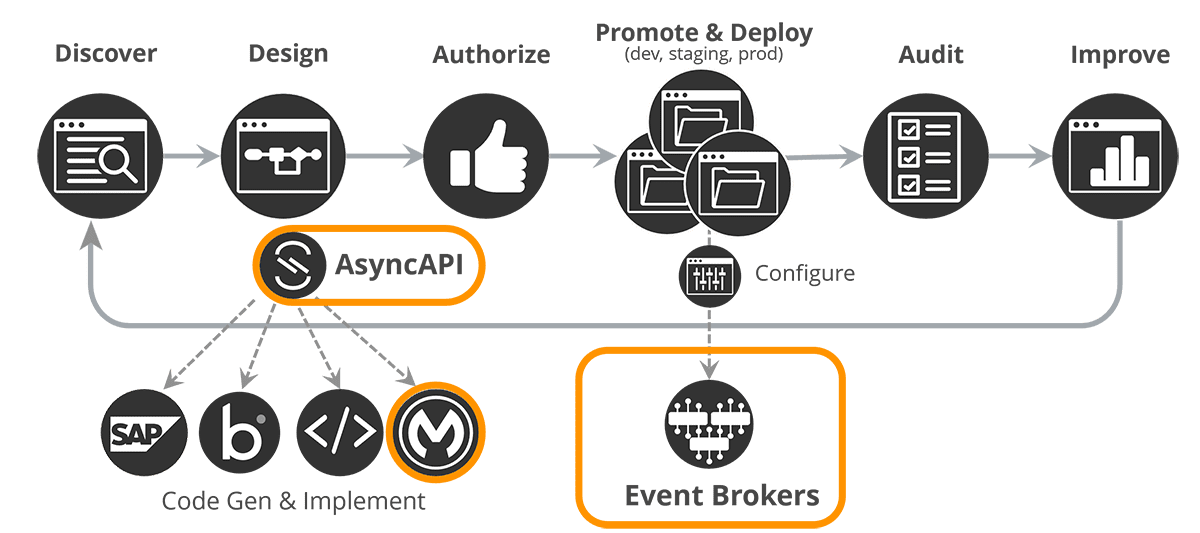Today, MuleSoft announced the open beta for AsyncAPI support in Anypoint Platform, and a vendor neutral approach to integrating with a variety of event brokers. In their announcement and corresponding product spotlight video, MuleSoft makes several great points as to why and how modern enterprises need and benefit from event-driven architecture (EDA), including:
Subscribe to Our Blog
Get the latest trends, solutions, and insights into the event-driven future every week.
- Increasing time sensitivity of information: Enterprises face a barrage of real-time data—fraud alerts, news updates, stock movements, and traditional synchronous communications can’t keep pace.
- Inefficiency of synchronous APIs: 98.5% of API polls return no new information.
- System Rigidity: The tight coupling of synchronous APIs restricts flexibility and magnifies the impact of failures.
- Consumer Experience Issues: Slow response times and non-availability cause sub-par consumer interactions.
MuleSoft goes on to explain that EDA enables businesses to deal with data and engage with customers in real-time by facilitating the creation of event-driven applications. Everything they’re saying totally jives with the way we’ve been predicting the industry will go:
- All kinds of enterprises have recognized the need to more effectively share information across silos in real-time, and are embracing event-driven architecture and event-driven integration to do so.
- Integrating systems in an event-driven manner requires new tooling as existing integration tools are focused on synchronous interactions.
- AsyncAPI will become the standard way everybody represents events, their schemas, and the application interfaces that publish and subscribe to events.
- Traditional iPaaS and integration vendors will hop on the train as customer demand increases – with this announcement MuleSoft joins Boomi, SAP and others in doing so.
This is happening, people! MuleSoft is fully embracing EDA, and Solace has already been refining the process and developer experience of creating event-driven integrations with MuleSoft for some time.
Why? Easy: Our customers have been asking for better event-driven integration capabilities with MuleSoft and Solace. In addition, we are engaged with several large enterprises that are successfully using our new event-driven integration tooling with MuleSoft.
Consider the following journey and lifecycle diagram:
We have been working to hone the journey of a user, from discovering existing events, to designing new integration flows/application interfaces to finally governing the access and promotion processes.
I want to call out a few key areas of interest related to this journey: AsyncAPI, flow generation and event mesh.
AsyncAPI as Ubiquitous Eventing Standard
AsyncAPI is a key part of what MuleSoft announced and what we do at Solace, but there are a couple of key distinctions, primarily in the value our Solace Event Portal product adds around the specification.
First, how does an AsyncAPI spec get created? Event Portal lets users easily find existing event types or create new event types through an easy set of dialogs. Event Portal also abstracts away AsyncAPI limitations such as ownership, versioning and reusability of each AsyncAPI component (channels, schemas). Finally, Event Portal provides an easier path to AsyncAPI document creation and helps get developers writing MuleSoft Integration Flows faster.
Easy and Consistent Flow Code Generation
Creating flows for event-driven integrations can be a real pain, and integrations are frequently way more complicated than they need to be. We know that, as many of us come from writing integration flows ourselves.
We’ve developed a plugin that lets you export an AsyncAPI specification from Event Portal and generate a MuleSoft Integration Flow, all within the Anypoint Studio IDE. Simply download and install the Solace Micro-Integration Generator for MuleSoft Anypoint Platform, connect it to your event portal, and away you go! You’ll be able to take predefined MuleSoft Flow interface definitions and easily crank out rock-solid flows using our best practices.
Event Mesh for Data Distribution
Solace has pioneered the concept of event mesh – a network of inter-connected event brokers that dynamically routes events to any system anywhere in the world, running in any environment. This makes many challenges associated with moving the right event to the right MuleSoft Flow — which can be tricky today — easy by using Solace Event Broker. You can’t implement this type of system with Kafka, AnypointMQ, or cloud-native messaging solutions like Amazon SQS/SNS and Google PubSub. Each of these brokers have their place, but not as the event mesh and distribution layer of a large enterprise. Besides, very few enterprises have consolidated on just one cloud or integration technology. An event mesh enables a decentralized, interconnected, bi-modal integration landscape.
Want to see it in action?
Hopefully you found a few of these areas interesting and thought provoking. Want to see it in action? Check out “Creating an Event-Led Integration Lifecycle with Mule x Solace”. It’s a 5 min video that walks you through and demonstrates the power of using Solace with MuleSoft for event-driven integration. If you’re wondering whether you really have an event-driven integration problem, check out this post to see how another client I visited this week thought about their challenges and how we proposed they decompose the problem.
Conclusion
I am personally excited to see Mulesoft lean into event-driven integration. Solace is committed to pushing the envelope of “that’s possible” with real-time event-driven integration. So, if you’re using an integration technology such as MuleSoft, or maybe something else, and are interested in making your integration better and real-time, let’s chat!
Event Driven Integration with iPaaS - The Architect's Guide to ImplementationIn this guide, you will learn how pairing an iPaaS with an event broker will help you create a robust and scalable architecture and the technical steps you need to take to start reaping the benefits of event-driven integration
Explore other posts from categories: Event-Driven Integration | For Architects

 Jonathan Schabowsky
Jonathan Schabowsky






